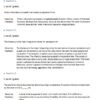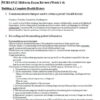Description
NURS 6512 Midterm Exam 2 – Advanced Health Assessment
- Under normal circumstances, how much water is lost daily by the body?
- The most common form of birth trauma of the scalp is:
- The review of systems is a component of the:
- Which of the following is an expected change in the assessment of the thyroid during pregnancy?
- As you explain your patient’s condition to her husband, you notice that he is leaning toward you and pointedly blinking his eyes. Knowing that he is from England, your most appropriate response to this behavior is to:
- Bulging of an amber tympanic membrane without mobility is most often associated with:
- When palpating the abdomen, you should note whether the liver is enlarged in the:
- Underestimation of blood pressure will occur if the blood pressure cuff’s width covers:
- Ms. Jones is a 31-year-old female patient who presents for a routine physical examination. Which examination technique will be used first?
- Placing the base of a vibrating tuning fork on the midline vertex of the patient’s head is a test for:
- A 22-year-old female nurse is interviewing an 86-year-old male patient. The patient avoids eye contact and answers questions only by saying, “Yeah,” “No,” or “I guess so.” Which of the following is appropriate for the interviewer to say or ask?
- Which is the best way to position a patient’s neck for palpation of the thyroid?
- When are open-ended questions generally most useful?
- You are palpating a patient’s thyroid and find that its broadest dimension measures 4 cm. The right lobe is 25% larger than the left. These data would indicate:
- A 5-year-old child presents with nasal congestion and a headache. To assess for sinus tenderness you should palpate over the:
- Mr. Kevin Marks is a new health care provider. What is the best method to develop cultural competence?
- A 51-year-old woman calls with complaints of weight loss and constipation. She reports enlarged hemorrhoids and rectal bleeding. You advise her to:
- Inspection of the abdomen should begin with the patient supine and the examiner:
- Mr. Williams, age 25, has recovered recently from an upper and lower respiratory infection. He describes a long-standing nasal dripping. He is seeking treatment for a mild hearing loss that has not gone away. Information concerning his chronic postnasal drip should be documented within which section of his history?
- When hearing is evaluated, which cranial nerve is being tested?
- As part of your health promotion education for a new patient, you explain that the risk factors for skin cancer include:
- You are completing a general physical examination on Mr. Rock, a 39-year-old man with complaints of constipation. When examining a patient with tense abdominal musculature, a helpful technique is to have the patient:
- The position on a clock, topographic notations, and anatomic landmarks:
- Tympanic thermometers measure body temperature when a probe is placed:
- The examiner’s evaluation of a patient’s mental status belongs in the:
- Mrs. Tuber is a 36-year-old patient who comes into the health center with complaints that her fingernails are not growing. Which structure is the site of new nail growth?
- Mrs. Hartzell is a 34-year-old patient who has presented for nutritional counseling because she is a vegetarian. Deficiency of which of the following is a concern in the vegetarian diet?
- Mr. Marks is a 66-year-old patient who presents for a physical examination to the clinic. Which question has the most potential for exploring a patient’s cultural beliefs related to a health problem?
- In issues surrounding ethical decision making, beneficence refers to the:
- Penicillin is considered a
- To perform the Rinne test, place the tuning fork on the:
- Mr. Donalds is a 45-year-old roofer. Your inspection to determine color variations of the skin is best conducted:
- Which technique is most likely to result in the patient’s understanding of questions?
- Regardless of the origin, discharge is described by noting:
- The adult recommended dietary fat intake should be _____ g/day.
- When assessing abdominal pain in a college-age woman, one must include:
- George Michaels, a 22-year-old patient, tells the nurse that he is here today to “check his allergies.” He has been having “green nasal discharge” for the last 72 hours. How would the nurse document his reason for seeking care?
- Which of the following organs is part of the alimentary tract?
- The attitudes of the health care professional:
- In examining the neck of a 34-year-old female patient, you note that the uppermost ridge of the tracheal cartilage is at the:
- A serous membrane that lines the abdominal cavity and forms a protective cover for many abdominal structures is the:
- Which of the following is an “ABCD” characteristic of malignant melanoma?
- The term denoting the caregiver’s need to do no harm to the patient is:
- A flat, nonpalpable lesion is described as a macule if the diameter is:
- A college student comes to the student health center complaining of difficulty in concentrating during class and while studying. The diet that would contribute to this problem is one that consumes mostly:
- You are planning to palpate the abdomen of your patient. Which part of the examiner’s hand is best for palpating vibration?
- During percussion, a dull tone is expected to be heard over:
- You are examining a pregnant patient and have noted a vascular lesion. When you blanche over the vascular lesion, the site blanches and refills evenly from the center outward. The nurse documents this lesion as a:
- Mrs. Grace is a 58-year-old patient who has a diagnosis of pernicious anemia. Which B vitamin is deficient in patients with pernicious anemia?
- Your patient presents with symptoms that lead you to suspect acute appendicitis. Which assessment finding is least likely to be associated with this condition early in its course?
- The most superior part of the stomach is the:
- Mrs. Webb is a 38-year-old patient who has been changing her lifestyle to eat in a healthy way and lose weight. During your health promotion education regarding her nutritional status, you explain the function of dietary protein as:
- Ms. G. is being seen for her routine physical examination. She is a college graduate and president of a research firm. Although her exact salary is unknown, she has adequate health insurance. Most of the above information is part of Ms. G.’s _____ history.
- Your patient is complaining of acute, intense sharp epigastric pain that radiates to the back and left scapula with nausea and vomiting. Based on this history, your prioritized physical examination should be to:
- Mrs. Britton brings her 16-year-old son in with a complaint that he is not developing correctly into adolescence. Which structures disproportionately enlarge in the male during adolescence?
- Before performing an abdominal examination, the examiner should:
- Which statement is true regarding the relationship of physical characteristics and culture?
- Mr. Franklin is speaking with you, the health care provider, about his respiratory problem. Mr. Franklin says, “I’ve had this cough for 3 days, and it’s getting worse.” You reply, “Tell me more about your cough.” Mr. Franklin states, “I wish I could tell you more. That’s why I’m here. You tell me what’s wrong!” Which caregiver response would be most appropriate for enhancing communication?
- Before performing an abdominal examination, the examiner should:
- Sweat glands, hair, and nails are all formed from:
- Subjective and symptomatic data are:
- Mr. D. complains of a headache. During the history, he mentions his use of alcohol and illicit drugs. This information would most likely belong in the:
- Which technique is most likely to result in the patient’s understanding of questions?
- Peritonitis produces bowel sounds that are:
- You are using an ophthalmoscope to examine a patient’s inner eye. You rotate the lens selector clockwise, then counterclockwise to compensate for:
- When communicating with older children and teenagers, you should be sensitive to their:
- Percussing at the right midclavicular line, below the umbilicus, and continuing upward is the correct technique for locating the:
- A guideline for history taking is for caregivers to:
- Mr. Mills is a 55-year-old patient who presents to the office for an initial visit for health promotion. A survey of mobility and activities of daily living (ADLs) is part of a(an):
- A tool used to screen adolescents for alcoholism is the:
- Which of the following is the most accurate reflection of an individual’s food intake?
- What finding is unique to the documentation of a physical examination of an infant?
- Fluorescing lesions are best distinguished using a(n):
- Mr. Abdul is a 40-year-old Middle Eastern man who presents to the office for a first visit with the complaint of new abdominal pain. You are concerned about violating a cultural prohibition when you prepare to do his rectal examination. The best tactic would be to:
- Mr. L. presents to the clinic with severe groin pain and a history of kidney stones. Mr. L.’s son tells you that, for religious reasons, his father wishes to keep any stone that is passed into the urine filter that he has been using. What is your most appropriate response?
- In counseling a client regarding nutrition education, you explain that linoleic acid, a major fatty acid, is thought to be essential for:
- Peritonitis produces bowel sounds that are:
- Which part of the information contained in the patient’s record may be used in court?
- After thorough inspection of the abdomen, the next assessment step is:
- White, rounded, or oval ulcerations surrounded by a red halo and found on the oral mucosa are:
- Your patient returns for a blood pressure check 2 weeks after a visit during which you performed a complete history and physical. This visit would be documented by creating a(n):
- Your patient is complaining of acute, intense sharp epigastric pain that radiates to the back and left scapula with nausea and vomiting. Based on this history, your prioritized physical examination should be to:
- Mrs. Kinder is a 39-year-old patient who presents to the office with complaints of an earache. In explaining to the patient about the function of her ears, which ear structure would you tell her is responsible for equalizing atmospheric pressure when swallowing, sneezing, or yawning?
- Pigmented, raised, warty lesions over the face and trunk should be assessed by an experienced practitioner who can distinguish:
- Ms. Davis is a 27-year-old patient with a BMI of 33. Based on her BMI, your diagnosis would be:
- Small, minute bruises are called:
- To approximate vocal frequencies, which tuning fork should be used to assess hearing?
- When assessing abdominal pain in a college-age woman, one must include:
- Tracheal tug suggests the presence of a(n):
- To correctly document absent bowel sounds, one must listen continuously for:
- Which of the following formats would be used for visits that address problems not yet identified in the problem-oriented medical record (POMR)?
- Mr. Sanchez is a 45-year-old gentleman who has presented to the office for a physical examination to establish a new primary care health care provider. Which of the following describes a physical, not a cultural, differentiator?
- Brittle nails are typical findings in:
- Ms. Otten is a 45-year-old patient who presents with a complaint of weight gain. Which medication is frequently associated with weight gain?
- Spasmodic muscular contractions of the head, face, or neck are called:
- Tuning forks with a frequency of 500 to 1000 Hz are most commonly used to measure:
- Coarse, dry, and brittle hair is associated with which metabolic disorder?
- When recording physical findings, which data are recorded first for all systems?
- A detailed description of the symptoms related to the chief complaint is presented in the:
- Recommended carbohydrate content of total dietary intake (% total calories) is ____%.








